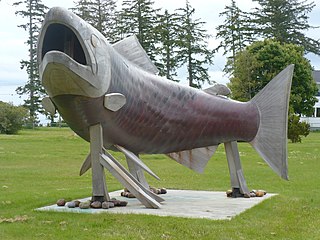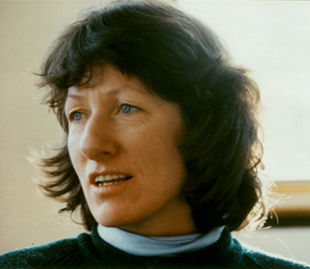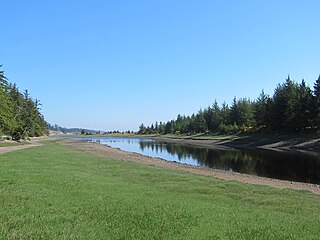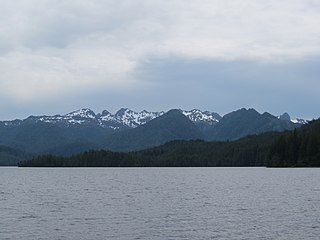
Haida Gwaii, formerly known as the Queen Charlotte Islands, is an archipelago located between 55–125 km (34–78 mi) off the northern Pacific coast of Canada. The islands are separated from the mainland to the east by the shallow Hecate Strait. Queen Charlotte Sound lies to the south, with Vancouver Island beyond. To the north, the disputed Dixon Entrance separates Haida Gwaii from the Alexander Archipelago in the U.S. state of Alaska.

Hecate Strait is a wide but shallow strait between Haida Gwaii and the mainland of British Columbia, Canada. It merges with Queen Charlotte Sound to the south and Dixon Entrance to the north. About 140 kilometres (87 mi) wide at its southern end, Hecate Strait narrows in the north to about 48 kilometres (30 mi). It is about 260 kilometres (160 mi) in length.

Sandspit is the largest community on Moresby Island, in Haida Gwaii off the Pacific coast of British Columbia, Canada. The only town on Moresby Island, Sandspit has accommodations, a campground, supermarket and 85-berth harbour serving visitors to Gwaii Haanas.
Port Clements is an incorporated village situated at the east end of Masset Inlet in Haida Gwaii off the coast of the Province of British Columbia in Canada. Known as Gamadiis in HlG̱aagilda X̱aayda kil, it is one of seven village sites that flourished in the rich waters at the mouth of Yakoun River, where an estuary shelters nine Pacific salmonid species and many kinds of birds. Founded by Eli Tingley in 1907, it was once known under the name Queenstown, but renamed to Port Clements in 1914 after Herb S. Clements, the local MP at the time, when the name "Queenstown" duplicated and therefore became unusable for the post office.

Colleen McCrory was a Canadian environmental activist.

Naikoon Provincial Park is a provincial park on northeastern Graham Island in the Haida Gwaii archipelago, British Columbia, Canada. It is the ancestral home of the Gwak'rala'chala people, one of the many tribes that form the native group Haida. While it is a popular destination for adventurous campers, it is also very secluded, being over 16 km (9.9 mi) away from Masset.

Campania Island is an island on the coast of the Canadian province of British Columbia. It is located south of Prince Rupert, east across Hecate Strait from Haida Gwaii. To its west, across Estevan Sound, is the Estevan Group archipelago. Banks Island lies to the northwest, across Nepean Sound; and Pitt Island to the north, across Otter Channel. To the northeast, across Squally Channel, is Gil Island, and to the east is Princess Royal Island, across Campania Sound. To the south of Campania Island is Caamaño Sound, beyond which is Aristazabal Island.
The Yakoun River is the largest river of Haida Gwaii, in the province of British Columbia, Canada. Located on Graham Island it flows about 58 km (36 mi) from Yakoun Lake north to Masset Inlet, a large saltwater bay located in the heart of the Graham Island and connected to the Pacific Ocean at Dixon Entrance via a long narrow inlet called Masset Sound.
Slatechuck Creek is a short but culturally important stream on Graham Island in the Queen Charlotte Islands of the North Coast of British Columbia, Canada. Only 6.7 km in length, it is located on the south flank of the small range including Slatechuck Mountain, to the north of which is Yakoun Lake, the headwaters of the Yakoun River. Its main left tributary, Kagan Creek, is named for Slatechuck Mountain, whose name in the Haida language is Kaagan.

Masset Inlet is a large saltwater bay located in the heart of the lowland of northern Graham Island, the northernmost and largest island of the Haida Gwaii islands on the North Coast of British Columbia, Canada. It is fed by several rivers, the largest of which is the Yakoun River, and is connected to the open sea of the Dixon Entrance by the narrow Masset Sound and Masset Harbour, which opens onto McIntyre Bay. The communities of Port Clements and Sewall are located on the shores of Masset Inlet. The community of Juskatla is located on Juus Ḵáahlii, the largest of Masset Inlet's arms. There are several islands in the inlet, the largest of which is Kumdis Island, at the inlet's egress to Masset Sound and just north of Port Clements. Masset Inlet helps form the isthmus of the Naikoon Peninsula.
Old Massett Village Council is a band government of the Haida people, located in Old Massett, on Haida Gwaii. Old Massett Village Council is one of two Canadian band governments for the Haida Nation, the other is the Skidegate Band Council. The main governing body of the Haida people is the Council of the Haida Nation.

The Tlell River is a watercourse on the east side of Graham Island in Haida Gwaii, British Columbia, Canada. It enters Hecate Strait near the community of Tlell. It is the second-longest river in Haida Gwaii, after the Yakoun. Its lower reaches are within Naikoon Provincial Park. The Tlell's headwaters and the swamps of its upper reaches are protected within the Tlall Conservancy. The river is popular with anglers, as it supports large coho salmon.

Skidegate Inlet is a broad inlet on the east coast of the Haida Gwaii archipelago of the North Coast of British Columbia, Canada. It is the easternmost of a series of waterways separating Graham Island to the north from Moresby Island to the south.

Rainbow/Q'iwentem Provincial Park is a recently established 385 hectare provincial park in the Cariboo region of British Columbia. The park was established in 2013, protecting the land between Sulphurous Lake and Deka Lake. While there are no developed trails in the park, existing routes used by locals exist connecting roads on the North Shore of Deka Lake to the North Shore of Sulphurous Lake. The park is accessible by road only from the southwest.
Duu Guusd Heritage Site/Conservancy is a heritage site and conservancy located in the northwest corner of Graham Island in the Haida Gwaii archipelago of British Columbia, Canada. It was established on March 23, 2008 to protect the ecological integrity and cultural importance of the region. The conservancy is part of an archipelago-wide system of protected areas that includes Gwaii Haanas National Park Reserve and Haida Heritage Site, Gwaii Haanas National Marine Conservation Area Reserve and Haida Heritage Site, and 17 other provincially protected areas.
Kaisun, also Ḵaysuun, Qaysun, Qaysun Llanagaay, or Sealion Town, is a former village of the Haida people located on the west side of Moresby Island in Haida Gwaii of the North Coast of British Columbia, Canada. The Haida of Kaisun were Qayahl Llaanas, the Sealion People, of the Eagle moiety. It was normal for members of both Haida moieties to live in a village. In Kaisun, houses of the Raven moiety were on the west side of the village, while Eagle houses were on the east side. There were close connections between Kaisun and the nearby village of Chaatl, about 10 km (6.2 mi) to the north in a straight line, or about 20 km (12 mi) by water.
Chaatl, also spelled Cha'atl, Tsaa'ahl, Tts’aa’ahl, and other variations, was a historic Haida village located on the shore of Chaatl Island, facing south across Buck Channel to the western side of northern Moresby Island, near the western end of Skidegate Channel, Haida Gwaii, British Columbia, Canada. Across Buck Channel from Chaatl was the long-abandoned village site of Niisii. There were close connections between Chaatl and the nearby village of Kaisun, about 10 km (6.2 mi) to the south in a straight line, or about 20 km (12 mi) by water.

Yaaguun Suu Conservancy is a conservancy in Haida Gwaii, British Columbia, Canada. The total area is 7,970 hectares. It covers Yakoun Lake and its watershed.












